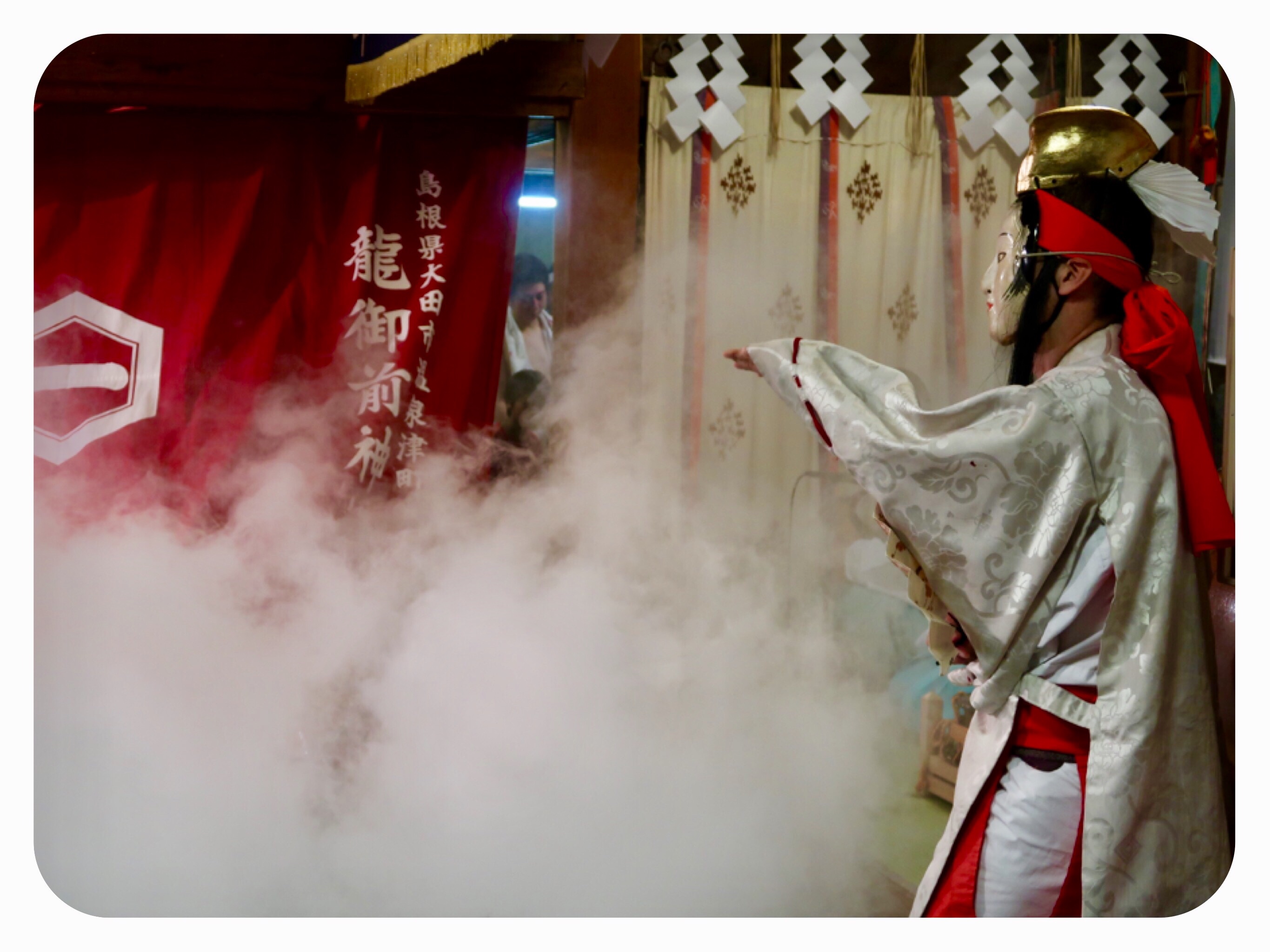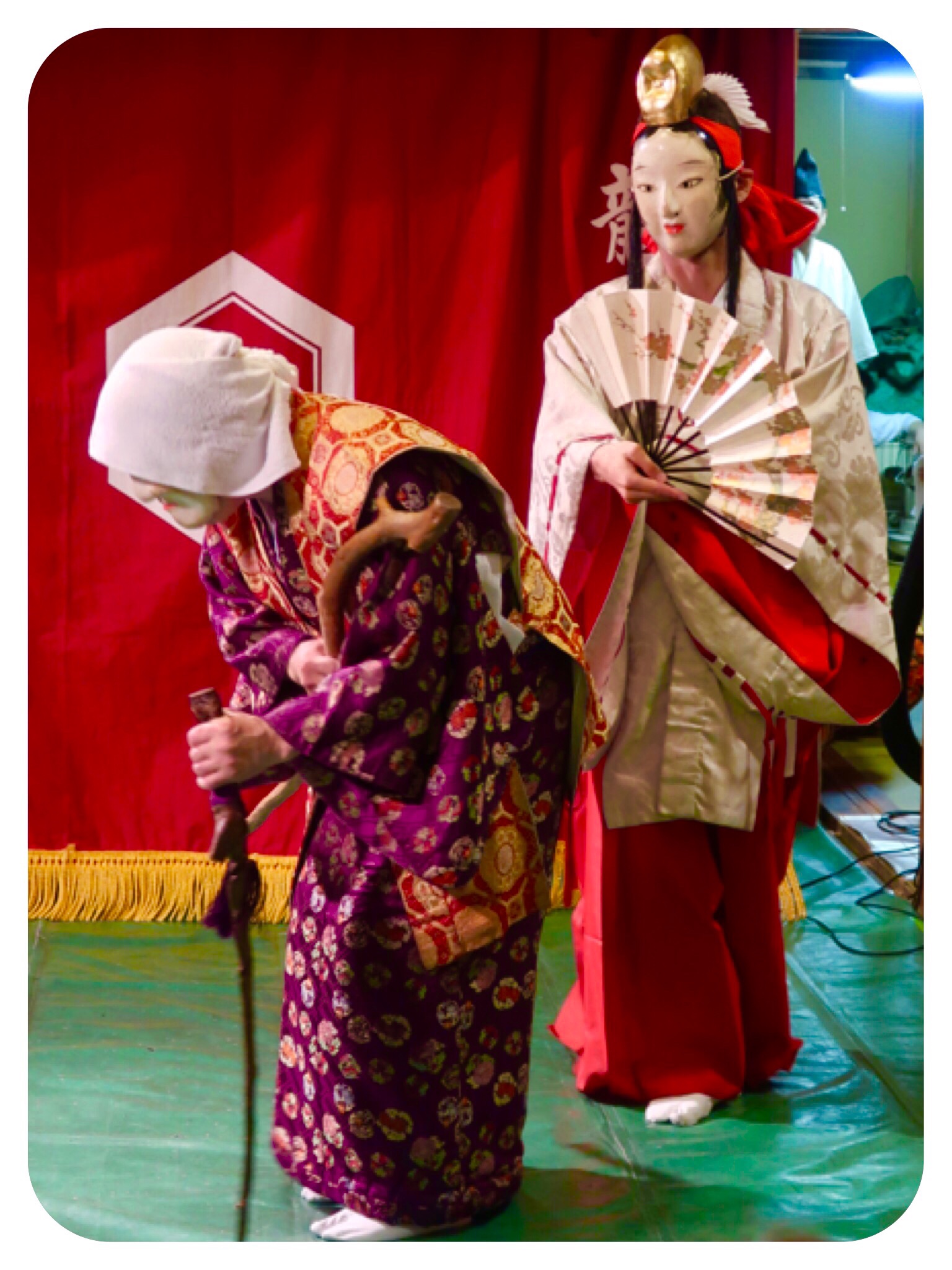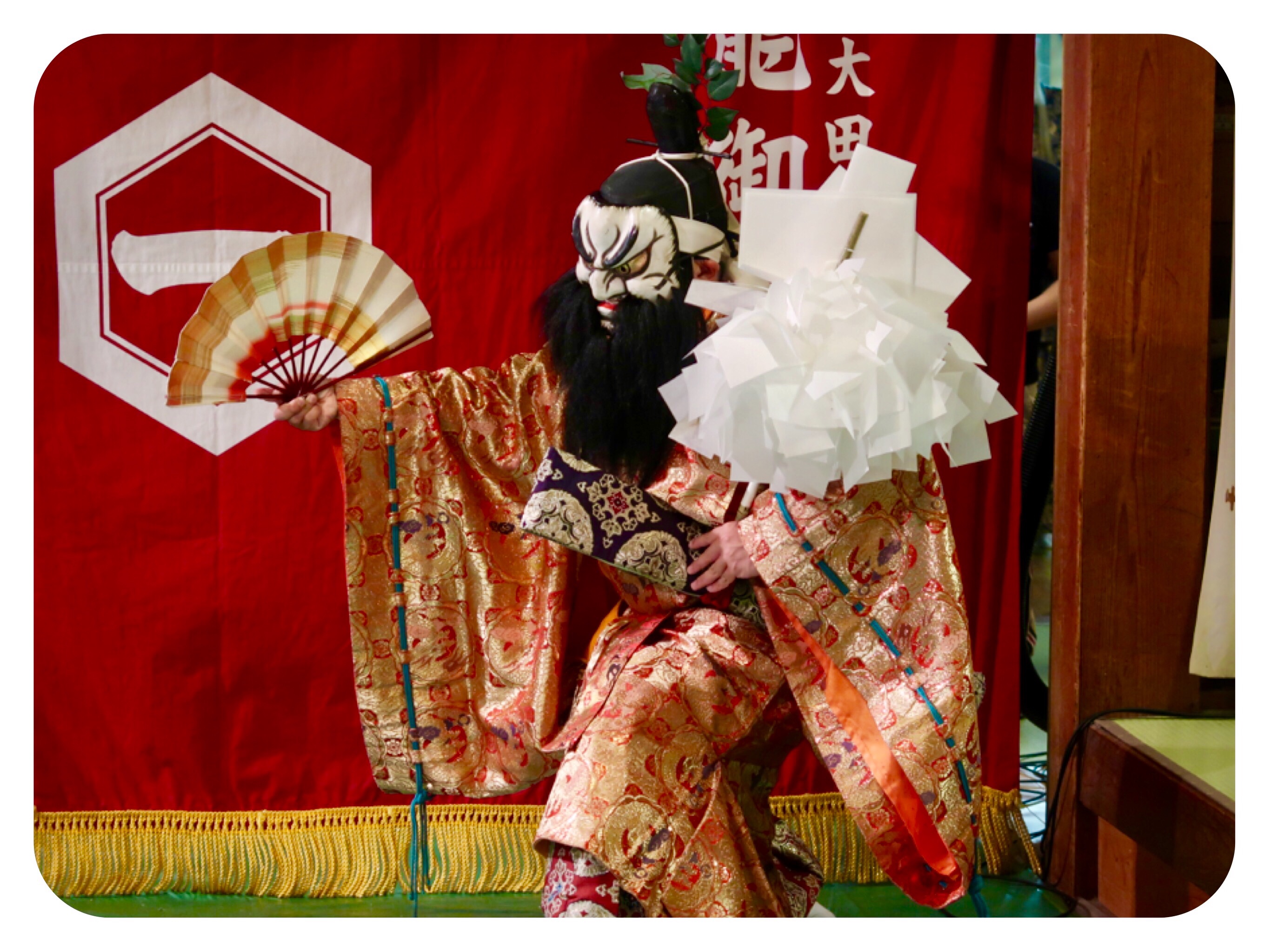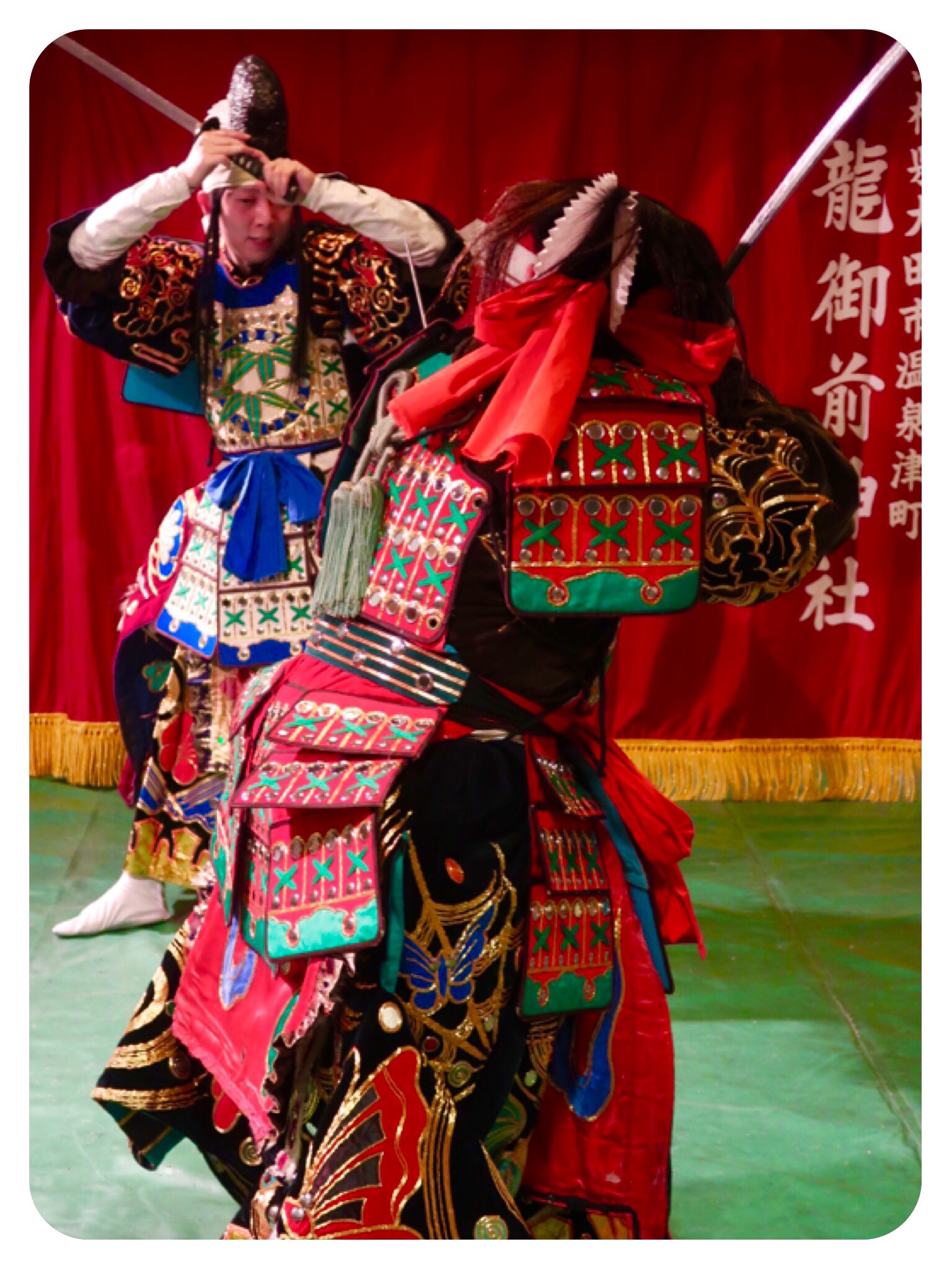Day 43 - The Chūgoku 33 Temple Kannon Pilgrimage, Japan - Seeing an Amazing Performance of Iwami Kagura in Yunotsu Onsen, and Visiting Kandoji Temple #23 in Izumo











































Day 43 - The Chūgoku 33 Temple Kannon Pilgrimage, Japan - Seeing an Amazing Performance of Iwami Kagura in Yunotsu Onsen, and Visiting Kandoji Temple #23 in Izumo
Today I feel like the luckiest person alive.
This pilgrimage has been exceeding all my expectations and more, and today, we had the rare and unplanned treat of seeing a regional theater troupe re-enacting mythical stories through song and dance, inside an old Shinto shrine.
We are staying for the next two nights in a very old onsen town called Yunotsu.
Yunotsu Onsen, which is known for its hot springs that have therapeutic effects, is located south of Oda City, in Shimane Prefecture.
Yunotsu has both mountains and a marina on the coast of the Sea of Japan.
It used to be known as a port town until the beginning of the 17th century, and it played an important role in shipping the silver mined in the ‘Iwami Ginzan Silver Mine,’ now a World Heritage Site.
The old town is dotted with inns and traditional Ryokans which offer their own baths.
There are also charming old style public baths, and a few shops along the streets.
Despite some decay and some closed shops, visitors can soak up the tranquil atmosphere of a town with a long history.
More than 1300 years ago, deep in the forest, it is said that a monk came upon an injured raccoon splashing in the spring water, and the raccoon was then healed.
Seeing this, the monk became certain that the spring water had therapeutic effects.
This raccoon has become a symbol of the town.
Our inn, Kiunso, is a charming and bright Ryokan.
We got a renovated traditional tatami room, that has beautiful wood elements embedded into the adobe mud covering the walls.
The living room is cosy, but the whole place feels like we have a mini apartment, with an entrance foyer to take off our sandals, a hallway with a wooden closet, and a covered mirror.
The mirror in traditional inns is always covered, since it is considered vain to be too concerned with how we look, and it is believed that mirrors only reflect momentary views of our states of mind, not our bodies.
The hallways lead to the bathroom, which has only a sink and a toilet.
Bathing is done upstairs in the hot spring baths.
The room also has a covered balcony with low chairs overlooking a lovely garden.
The temperature of the water in the hot spring baths varies.
The indoor bath is very hot, and has minerals that give the water a touch of a red tone.
The outdoor bath is a little less hot and has a milky, clear tone.
I sat mostly by myself in the outdoor bath, looking over the clay tiled roofs of the village and the stunning Buddhist temple with its red maple trees, growing over the rocky cliff behind it.
I felt serene, peaceful, indulgent and grateful.
Today we did not walk long.
Since we have been doing so well on our walks, we could afford to slow down and take a partial rest day.
The weather forecast called for rain, so after we checked out of our hotel in Shimoko, we took the train to Izumo.
We planned to walk to temple #23 and then walk towards temple #24, located up on a mountain range.
In Izumo we walked to Kandoji, temple #23.
It was an easy walk, since this is an urban temple, which used to be affiliated with Izumo Taisha, the famous Shinto shrine in Izumo.
The temple grounds are surrounded by a forest of trees and bamboo reeds.
It was empty of people, and the main hall was locked.
Inside the main Kanon-do hall, is enshrined an image of the Buddha made in the early Heian period, which is believed to be a masterpiece depicting compassion, love and charity.
We did not get to see it, because the main hall was locked.
We performed our rituals, chanted the Heart Sutra and lit three sticks of incense.
Then we went to the office and rang the bell.
A friendly woman came out and stamped our book and scroll.
She asked us what we were doing there and gifted us two small images of the Goddess Kannon, to keep in our wallets as talismans.
From there we walked towards the next temple, and stopped along the way for a tea and cookie break at a Starbucks inside a large shopping mall.
We continued walking until 3:30 PM, when we took the train back to our ryokan in Yunotsu Onsen.
The women who checked us in, arranged for our meal times and showed us a brochure of a performance that would be taking place that night in the old Shinto Shrine in town.
We requested to have our dinner early, at seven PM, so we would have time to make it to the performance.
Dinner was served in our room and was a lovely Kaiseki feast.
After we had dressed up in our Yukatas, the hotel gave us traditional wooden Geta sandals, and we waddled along the dark street to the shinto shrine.
Inside, the shrine was full of people sitting on tatami mats.
Four musicians were seated at the back of the small stage.
The actors were dressed in handmade costumes with vivid patterns.
Some wore masks, based on the characters they played.
The dances were dynamic and expressive, and even without knowing the
stories or understanding the songs, it was easy to follow what was going on.
The Iwami-Kagura dance tradition started a long time ago.
“Iwami” is the name of the western district of Shimane Prefecture in Japan.
“Kagura” is the traditional sacred dance (called Kagura-Mai) to the God/Goddess of the local Shinto shrine, during annual rice-crop growth festivities.
The traditional Shinto ritualistic ceremony still takes place at the main alter of the shrine.
The Shinto priests and the female attendants perform a simple yet graceful sacred service dance called Mai.
Then a series of Iwami-Kagura dances, episodes or stories, follow this ceremony, taking place on the Kagura-Den (sacred stage) in the precincts of the shrine, from early night until dawn.
Each episode is vividly orchestrated by dynamic drum beats and beautiful nostalgic melodies played on the bamboo flute, accompanied by the stimulating metal sounds of small brass hand-held cymbals.
The episodes are performed by a group of 15 to 30 members of the local village or the town’s people, such as rice growing farmers, fishermen, salary men, store keepers and truck drivers.
The families and kids all participate in orchestrating the event.
The Iwami-Kagura is different from the Japanese traditional Kabuki (whose audience is mainly town people) and Noh (which is very slow, and whose audience were the feudal lords and samurai.) The audience for the Iwami-Kagura is the villagers or the rural communities.
Kabuki theater is a popular dramatic art form that has been a favorite among the Japanese people since the 17th century.
Noh is the oldest dramatic art in Japan, having originally developed in the 14th century.
The Iwami-Kagura started in the early Edo period (17th to 19th centuries).
It became very popular after the 1970’s Osaka Exposition, when a special tour performance took place at the exhibition site.
We sat watching in awe, as the melancholy bamboo flute played a melody accompanied by dynamic drum and cymbal beats .
My favorite piece was the dragon slayer/warrior.
The actors were dressed in costumes that are hand-made and intricately sewn Kimonos, with glittering gold and silver threads.
The masks were exaggerated, vividly colored and deformed to emphasize the original nature of good and evil characters.
From the dry ice smoke, emerged four colorful dragons.
The dragons moved in spiraling motions and had fabulous masks.
All together, it was a night that elevated me and made my artistic heart sing.
Iwami-Kagura, during the last few decades, has become a major part of local festivities in the Iwami region.
It is now performed every Saturday night in the Shrine in Yunotsu Onsen, and it can be seen in various local memorial events, and even at some Buddhist temples.
If you are in Shimane Prefecture and you get a chance, do not miss it.
It is a very exciting performance.
With blessings and love,
Tali
Daily Stats:
Steps: 19,906 steps
Distance Walked: 15 Kilometers
Active Walking: 4 hours
Total Time: 4.5 hours
Total distance walked on the pilgrimage so far: 902 Kilometers
Temple Visited: Temple #23 Kandoji Temple 神門寺
Accommodation: Yunotsu Onsen Ryokan Kiunso.
A traditional renovated Onsen Ryokan, in Yunotsu.
Has a nice cafe, open until 10pm.
Offers traditional hospitality, has indoor and outdoor hot spring baths, tatami mat rooms and a classical Kaiseki dinner and breakfast.